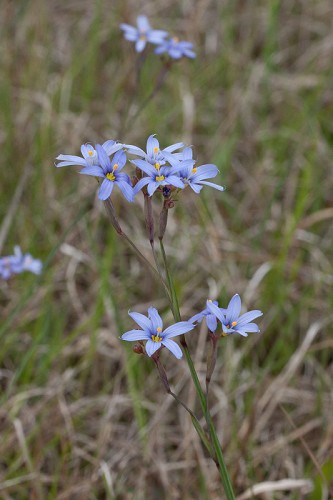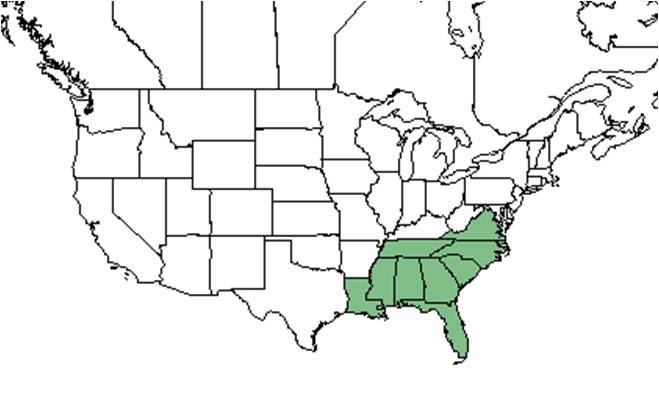Difference between revisions of "Sisyrinchium nashii"
Krobertson (talk | contribs) |
|||
| Line 38: | Line 38: | ||
===Pollination=== | ===Pollination=== | ||
| − | The following Hymenoptera families and species were observed visiting flowers of ''Sisyrinchium nashii'' at Archbold Biological Station | + | The following Hymenoptera families and species were observed visiting flowers of ''Sisyrinchium nashii'' at Archbold Biological Station: <ref name="Deyrup 2015">Deyrup, M.A. and N.D. 2015. Database of observations of Hymenoptera visitations to flowers of plants on Archbold Biological Station, Florida, USA.</ref> |
Halictidae: ''Lasioglossum coreopsis'' | Halictidae: ''Lasioglossum coreopsis'' | ||
| Line 53: | Line 53: | ||
==References and notes== | ==References and notes== | ||
| − | |||
Revision as of 19:29, 8 August 2016
| Sisyrinchium nashii | |
|---|---|

| |
| Photo by John R. Gwaltney, Southeastern Flora.com | |
| Scientific classification | |
| Kingdom: | Plantae |
| Division: | Magnoliophyta - Flowering plants |
| Class: | Liliopsida – Monocotyledons |
| Order: | Liliales |
| Family: | Iridaceae |
| Genus: | Sisyrinchium |
| Species: | S. nashii |
| Binomial name | |
| Sisyrinchium nashii E.P. Bicknell | |

| |
| Natural range of Sisyrinchium nashii from USDA NRCS Plants Database. | |
Common name: Nash's blue-eyed grass
Contents
Taxonomic notes
Synonym: Sisyrinchium fibrosum E.P. Bicknell
Description
A description of Sisyrinchium nashii is provided in The Flora of North America.
Distribution
Ecology
Habitat
In the Coastal Plain in Florida and Georgia, S. nashii occurs in limestone glades, longleaf pine/scrub oak communities, longleaf pine/wiregrass flats, slashpine woodlands bordering a tidal marsh, Cyrilla-Cliftonia thickets, and xeric oak/saw palmetto scrubs. Soil types include loamy sand, sand, and sandy loam. Associated species include Sarracenia minor, Calopogon, Schoenus nigricans, Sporobolus vaginiflorus, Dichanthelium commutatum, Polygala boykinii, and Echinacea purpurea[1].
Phenology
It flowers March through May and fruits April through May[1].
Fire ecology
S. nashii has been observed growing in frequently burned longleaf pine/wiregrass communities (FSU Herbarium).
Pollination
The following Hymenoptera families and species were observed visiting flowers of Sisyrinchium nashii at Archbold Biological Station: [2]
Halictidae: Lasioglossum coreopsis
Conservation and management
Cultivation and restoration
Historically, this species was used by the Miccosukee Indians as an analgesic and for moving sickness[3].
Photo Gallery
Flowers of Sisyrinchium nashii Photo by John R. Gwaltney, Southeastern Flora.com
References and notes
- ↑ 1.0 1.1 Florida State University Robert K. Godfrey Herbarium database. URL: http://herbarium.bio.fsu.edu. Last accessed: November 2015. Collectors: Loran C. Anderson, Wilson Baker, M. Davis, Angus Gholson Jr., Robert K. Godfrey, Ann F. Johnson, R. Komarek, Cecil R. Slaughter, Bian Tan. States and Counties: Florida: Bay, Columbia, Duval, Franklin, Gadsden, Jackson, Leon, Liberty, Nassau, Osceola, Pasco, Wakulla. Georgia: Baker, Grady, Thomas. Compiled by Tall Timbers Research Station and Land Conservancy.
- ↑ Deyrup, M.A. and N.D. 2015. Database of observations of Hymenoptera visitations to flowers of plants on Archbold Biological Station, Florida, USA.
- ↑ [[https://books.google.com/books?id=7qgPCEiI4WMC&pg=PA626&lpg=PA626&dq=Sisyrinchium+nashii&source=bl&ots=uDj07y0vSO&sig=GdSsONWAbLyGpeGgpp3Fu1xjnWE&hl=en&sa=X&ved=0ahUKEwiI2vbnwMXLAhUCWj4KHW54Dv04ChDoAQhMMAk#v=onepage&q=Sisyrinchium%20nashii&f=false}}
